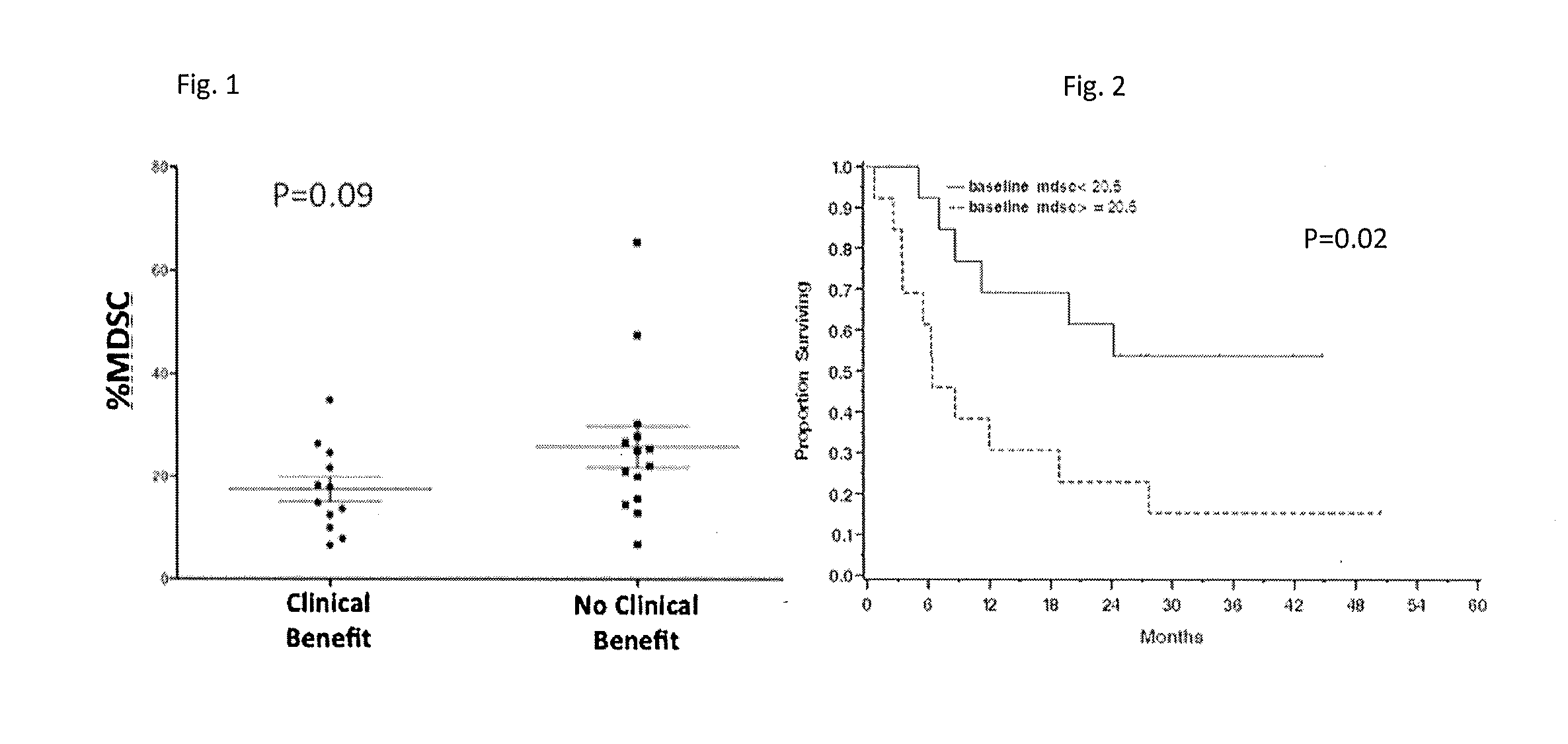Prediction of Responsiveness to Treatment with Immunomodulatory Therapeutics and Method of Monitoring Abscopal Effects During Such Treatment
a technology of immunomodulatory therapy and prediction of responsiveness to treatment, applied in the direction of immunological disorders, antibody medical ingredients, instruments, etc., can solve the problem that 30% of patients derive clinical benefit from therapy, and achieve the effect of enhancing immune activity, enhancing antitumor immunity, and increasing the likelihood of therapeutic efficacy
- Summary
- Abstract
- Description
- Claims
- Application Information
AI Technical Summary
Benefits of technology
Problems solved by technology
Method used
Image
Examples
example 1
[0028]Peripheral blood from 26 patients with stage IV melanoma treated with ipilimumab 10 mg / kg every 3 weeks for 4 doses as part of an expanded access program (BMS CA184-045) was assessed for the quantity (percentage) of CD14+HLA-DRlow cells) pre-treatment, at week 7, week 12, and week 24 by flow cytometry. MDSC ability to inhibit T cell proliferation was tested using an in vitro suppression assay.
[0029]Absolute lymphocyte count (ALC) was measured pre-treatment and at week 7 by using a routine complete blood count. LDH levels were also measured pretreatment in the peripheral blood
[0030]We found that lower PBM14+HLA-DRlow quantity pre-treatment indicated clinical benefit measured at week 24 imaging (p=0.09) and predicted for improved overall survival (Hazard ratio 1.07 (1.03, 1.11) p=0.002). (FIGS. 1 and 2) As can be seen in FIG. 1, the values for PBM14+HLA-DRlow quantity exhibited some scatter, but values below 20.5% tended to show a clinical benefit and those with values above 20....
example 2
[0034]A female patient was diagnosed with cutaneous melanoma in April, 2004 at age 33. Biopsy of a mole on her upper back revealed melanoma, non-ulcerated, with a Breslow thickness of 1.53 mm. She underwent a wide local excision of her primary lesion along with a left axillary sentinel lymph node biopsy. There was no residual melanoma at the primary site, and the five axillary lymph nodes removed were not involved. She remained disease-free until 2008 when a routine chest-x-ray revealed a new 2.0 cm pulmonary nodule in her left lower lobe. The nodule was hypermetabolic by positron emission tomography (PET) with a standard uptake value of 5.9. There were no additional sites of hypermetabolic foci. Cytology from a computed tomography (CT)-guided percutaneous biopsy of the pulmonary nodule revealed metastatic melanoma. Sequenom mass-spectrometry genotyping revealed no known mutations that affect the BRAF gene such as the BRAF V600E mutation.
[0035]Standard cisplatin, vinblastine, and te...
PUM
| Property | Measurement | Unit |
|---|---|---|
| thickness | aaaaa | aaaaa |
| discrimination threshold | aaaaa | aaaaa |
| concentration | aaaaa | aaaaa |
Abstract
Description
Claims
Application Information
 Login to View More
Login to View More - R&D
- Intellectual Property
- Life Sciences
- Materials
- Tech Scout
- Unparalleled Data Quality
- Higher Quality Content
- 60% Fewer Hallucinations
Browse by: Latest US Patents, China's latest patents, Technical Efficacy Thesaurus, Application Domain, Technology Topic, Popular Technical Reports.
© 2025 PatSnap. All rights reserved.Legal|Privacy policy|Modern Slavery Act Transparency Statement|Sitemap|About US| Contact US: help@patsnap.com


